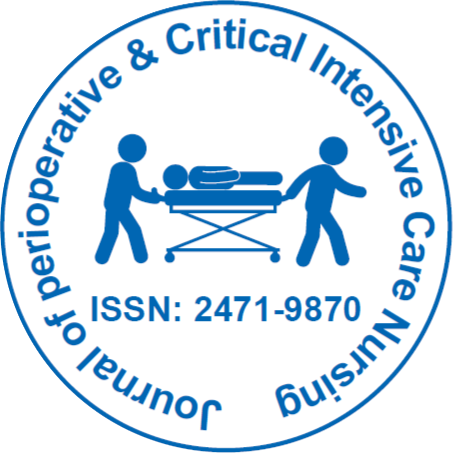
Journal of Perioperative & Critical Intensive Care Nursing
Open Access
ISSN: 2471-9870
+44-77-2385-9429

ISSN: 2471-9870
+44-77-2385-9429
Perspective - (2021)Volume 7, Issue 6
Unhealthiest prompts an increment in clinical costs, expanded length of emergency clinic stays, and helpless patient anticipation. Up to 40% of in‐hospital patients are impacted by "disease‐related ailing health," which is a particular kind of lack of healthy sustenance brought about by corresponding infection. To accomplish target energy for hospitalized patients who are in danger of failing health, it is essential to go to pre‐emptive lengths. In any case, in certain individuals with intense disease, oral admission of food may not offer the essential dietary benefit because of different reasons. The reasons might incorporate craving misfortune because of intense ailment, queasiness, heaving, early satiety, and trouble in gulping. This issue is particularly important in fundamentally sick patients, since oral admission is seriously impacted in such cases for reasons including the requirement for mechanical ventilation, gastrointestinal medical procedure, or obviousness. Patients under such conditions have higher death rates, and medical care providers should investigate the best intercessions to keep up with appropriate dietary status, particularly since nourishing administration has as of late been stressed as a significant determinant of patient endurance. Basically sick patients additionally show profoundly factor metabolic and invulnerable reactions to injury or ailment. Incendiary conditions result in expanded glycogenolysis, protein catabolism, and unsaturated fat debasement, and inadequate supplement consumption causes exhaustion of organ proteins, eventually prompting ailing health, and expanded danger of contamination and passing [1-3].
Under these conditions, enteral sustenance (EN) (enteral cylinder taking care of) or parenteral nourishment (PN) (the conveyance of calories and supplements into a vein) can make up for wholesome admission until oral admission becomes good. Patients with diminished supplement consumption from the gastrointestinal plot have an expanded danger of contamination in light of decreased stomach uprightness and the physiologic pressure reaction. In view of the better results in regards to disease, ongoing public rules supported by randomized controlled preliminaries (RCTs) or deliberate surveys, or both, have reliably proposed that EN ought to be utilized specially over PN in hospitalized patients who require non‐oral sustenance treatment, barring situations where EN is contraindicated. A new Cochrane Review of a wide range of nourishment support in hospitalized patients revealed that EN might reduce genuine antagonistic occasions [4].
An enormous number of microorganisms exist in the gastrointestinal plot, and the gastrointestinal mucosa goes about as a boundary against microbial disease. Besides, insusceptible tissue known as the Peyer's patches situated in the gastrointestinal mucosa assumes a preventive part against bacterial defilement of the body. It has been recommended that when supplements don't stream in the gastrointestinal lot, the gastrointestinal mucosa becomes decayed, leaving the individual defenceless to disease because of the decreased connection between the stomach and the fundamental safe reaction, and prompts helpless guess in basically sick patients. Specifically, for fundamentally sick patients with exceptionally factor metabolic and resistant reaction to injury or disease, early sustenance consumption through the digestive system that is enteral taking care of, is profoundly significant. Many investigations have proposed that in such patients, early enteral taking care of diminishes the pace of disease and mortality. As of now accessible clinical practice rules suggest that early EN ought to be administrated to patients, particularly to those in the emergency unit). Taking care of narrow mindedness is profoundly pervasive and is related with more awful results, particularly in fundamentally sick patients. It is in this manner basic to normalize evaluation of GI capacity and a bedside assessment of the mid-region. Indeed, even among the public rules, the greater part of which are for fundamentally sick patients, proposals on GRV checking change.
The American College of Gastroenterology and Society of Critical Care Medicine and American Society for Parenteral and Enteral Nutrition (SCCM/ASPEN) advise against GRV checking [5].
No enough controlled examinations need to date exhibited the most effective way to evaluate GRV, and no efficient audit has shown the risk‐benefit investigation of checking GRV in an all-inclusive community of hospitalized patients. Gastric lingering volume checking may likewise expand death rates, and accordingly investigating the best strategies for observing the GRV might diminish superfluous intercessions, guarantee patient wellbeing, and decrease costs. Since various techniques to screen the GRV exist, there is a quick requirement for studies to investigate the accompanying viewpoints.
Citation: Meiser A (2021) Nurse Performed Ultrasound Evaluation of Gastric Remaining Volume and Enteral Nasogastric Tube Arrangement in the Overall Emergency Unit. J Perioper Crit Intensive Care Nurs 7: 189. doi:10.35248/2471-9870.21.7.189
Received: 27-Oct-2021 Accepted: 10-Nov-2021 Published: 17-Nov-2021 , DOI: 10.35248/2471-9870.21.7.189
Copyright: © 2021 Meiser A et al. This is an open access article distributed under the term of the Creative Commons Attribution License, which permits unrestricted use, distribution, and reproduction in any medium, provided the original work is properly cited.